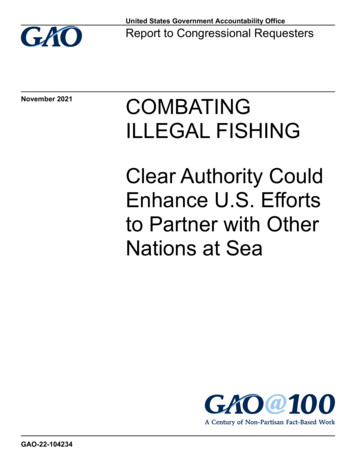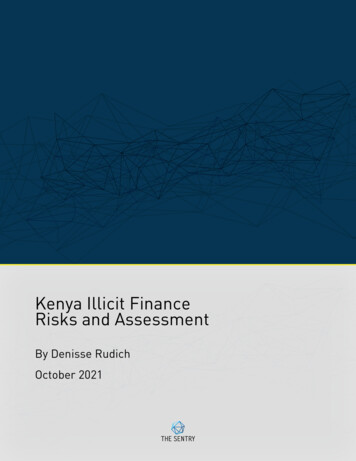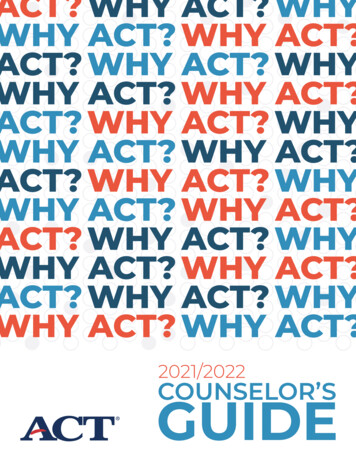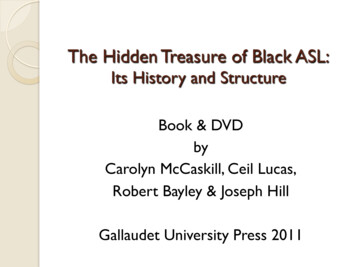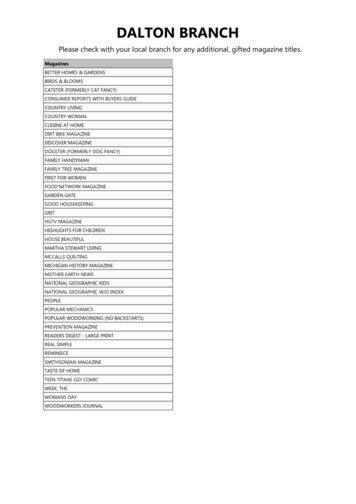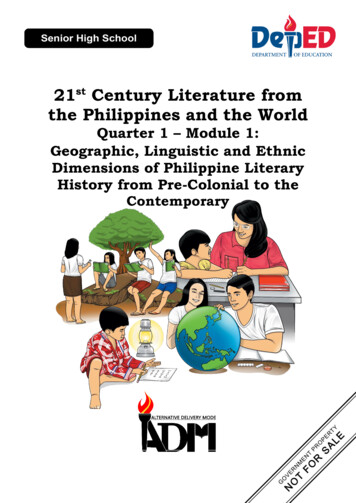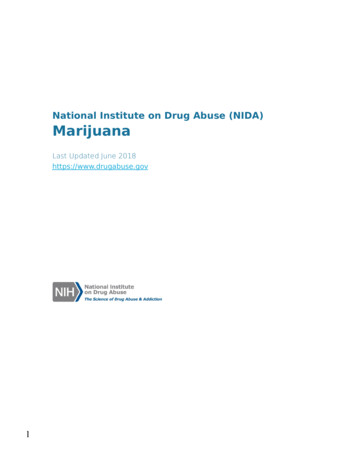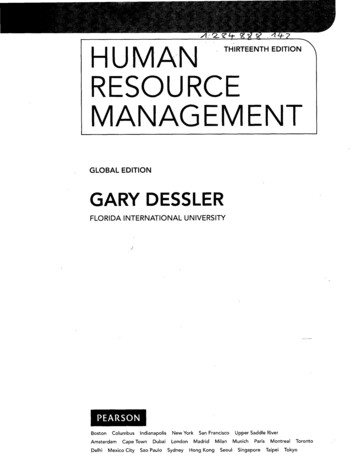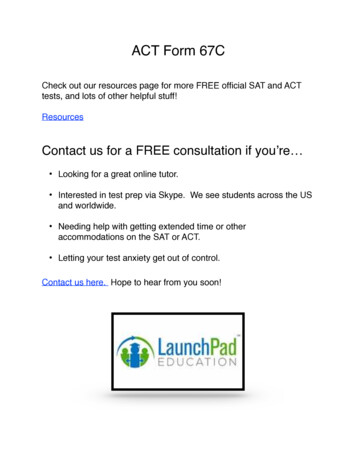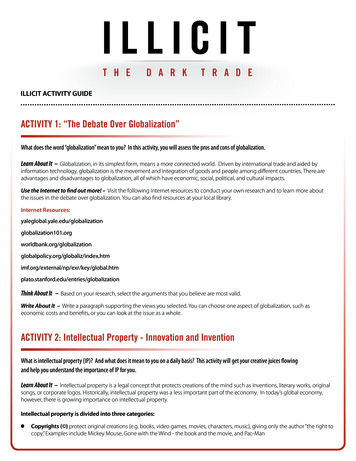
Transcription
T H ED A R KT R A D EILLICIT ACTIVITY GUIDEACTIVITY 1: “The Debate Over Globalization”What does the word “globalization” mean to you? In this activity, you will assess the pros and cons of globalization.Learn About It – Globalization, in its simplest form, means a more connected world. Driven by international trade and aided byinformation technology, globalization is the movement and integration of goods and people among different countries. There areadvantages and disadvantages to globalization, all of which have economic, social, political, and cultural impacts.Use the Internet to find out more! – Visit the following Internet resources to conduct your own research and to learn more aboutthe issues in the debate over globalization. You can also find resources at your local library.Internet ionThink About It – Based on your research, select the arguments that you believe are most valid.Write About It – Write a paragraph supporting the views you selected. You can choose one aspect of globalization, such aseconomic costs and benefits, or you can look at the issue as a whole.ACTIVITY 2: Intellectual Property - Innovation and InventionWhat is intellectual property (IP)? And what does it mean to you on a daily basis? This activity will get your creative juices flowingand help you understand the importance of IP for you.Learn About It – Intellectual property is a legal concept that protects creations of the mind such as inventions, literary works, originalsongs, or corporate logos. Historically, intellectual property was a less important part of the economy. In today’s global economy,however, there is growing importance on intellectual property.Intellectual property is divided into three categories:Copyrights ( ) protect original creations (e.g. books, video games, movies, characters, music), giving only the author “the right tocopy.” Examples include Mickey Mouse, Gone with the Wind - the book and the movie, and Pac-Man
Patents protect inventions for a period of time. Examples include new pharmaceuticals and airplane designs. rademarks (TM) protect the distinctive signs or logos used to distinguish different products or services. Examples include AppleTComputers apple, McDonald’s ‘golden arches’, and the Nike ‘swoosh.’Investigate It – To better understand how different types of Intellectual Property play a role in your daily life, try thefollowing activities: Complete an invention search at school, at home, or at the grocery store. Do this by listing as many inventions as you can withina given area. If you’re not sure, look for patent numbers on products.K eep track of the trademark names and/or company logos that you see between the time you leave your house in the morningand the time you go to bed.Conduct a copyright search by looking for the (copyright symbol) on items in your classroom or bedroom.Create It – Draw or make a model of your own invention. Be sure to give it an appropriate name.ACTIVITY 3: Counterfeiting and Piracy TheftLearn About It – The global economy is dependent upon the creation and distribution of intellectual property (IP) for growth.Increasingly, however, the economy is plagued by IP theft - often referred to as counterfeiting and piracy. As global trade booms andtechnology advances, fake products such as clothing and accessories, cosmetics, pharmaceuticals, auto parts, software, music, films,and everything in between are making their way to markets around the world.Illegal downloading, file sharing, and CD-burning are also considered IP theft. And, while most people would never even considerstealing something from a store, when it comes to stealing digital recordings of copyrighted music, they seem to think the same rulesdon’t apply—even though criminal penalties can be as high as five years in prison or 250,000 in fines.Many consider illegal trade, in the form of counterfeiting and piracy, “the crime of the 21st century.” People around the worldknowingly buy counterfeit and pirated goods, despite the fact that they are often produced by organized criminals and may helpfund additional criminal activities like human smuggling, drug trade, or terrorism. In addition, fake products are often manufacturedin “sweatshops” (harsh work conditions with little pay) and can include the use of child labor. Some of these products have also beenknown to explode or poison users.Map it – Think like a geographer! Use your geographic skills to map the nature and extent of the illegal trade problem. To start, readthe condensed versions of true news stories about counterfeiting and piracy (see “News Stories” handout attached). Then, make noteof the countries around the world that are impacted by illegal trade using the National Geographic Xpeditions world map at .Reflect On It – Ask yourself the following questions:I s there a pattern? Do you think any more significant patterns might arise if you mapped an additional series of new stories? Whattypes of patterns might you expect? Does the trade in counterfeit goods impact specific countries or regions? How so?.What do you think about the role and meaning of intellectual property in a world where information is instantly and equallyaccessible across the globe? How does piracy and/or counterfeiting impact you directly? Would you purchase counterfeit and/or pirated products? Why or why not?
Would you download pirated movies or music? Why or why not?I f people stopped buying fake products, would people stop selling them because there would be no profit?What do you think should be done to stop counterfeiting and piracy?Write About It – Develop a campaign against counterfeiting and piracy. Here are some ideas you might want to try: Create a list of the top ten reasons people should not buy counterfeit or pirated products. Develop a slogan that captures your anti-piracy and counterfeiting message in one easy-to-remember phrase.Write an article on the economic or consumer health and safety threats of counterfeiting and piracy. Translate what you’ve learned about counterfeiting and piracy into a fact sheet alerting other kids to the problem.Add graphics for impact.Content Development: Nancee Hunter, Writer; Alice Manning, NG Education & Children’s Programs, Editor; Chelsea Zillmer, Fact checker; Katie Wilson, U.S. Chambers, Reviewer;Kim Hulse, NG Education & Children’s Programs, Reviewer. Design: Patrick Truby. Project Management: Jeff Dow, NG Television & Film; Melissa Goslin, NG Education & Children’s Programs.
T H ED A R KT R A D ENews Story Handout1. Some of world’s largest record labels -- including Universal Music, Sony, BMG, EMI and Warner Music Group -- have filed a jointcopyright-infringement suit seeking 150,000 in damages from LimeWire for each song “willfully infringed” by the popular filesharing program. The suit, filed in New York federal court, asserts LimeWire permits users to download music illegally. The filing isthe latest in a series of lawsuits the music industry has filed to combat Internet piracy — an effort boosted by last year’s SupremeCourt ruling that content companies can take legal action against those who encourage copyright infringement. (Reuters)2. It’s become known as “the Watson’s Flea Market Raid.” It began at the peak of the sales day, when local police and corporateofficials wove through the crowd of bargain hunters like buyers with badges. They inspected the merchandise, comparingserial numbers on the products with computerized lists from the manufacturers, and confiscated carton after carton of fake RedMonkey jeans and knockoff Timberland boots. Allegations of selling stuff that purported to be something it wasn’t landed 20people in handcuffs that day, on charges of breaking state and federal licensing and trademark laws. Many economists traceglobal counterfeiting from the open-air markets of Shanghai to places like Watson’s Flea Market on the fringe of the Tar Heelcapital in Raleigh, North Carolina. Some 15,000 people pack in to browse what state officials say is 1 million in counterfeitdesigner jeans and Kate Spade handbags. The Watson’s raid was the biggest in a series of flea-market busts organized by NorthCarolina’s Secretary of State. Infractions of trademark and intellectual property law caught the state’s attention a few years agowhen licensed NASCAR vendors complained that fake Jimmie Johnson and Matt Kenseth hats and gear were being sold at races.Since then, officials have cited concern about public health and public safety, as counterfeiters expanded into appliances andother electrical products and even baby formula and pharmaceuticals. (Christian Science Monitor)3. During the past 12 months U.S. Customs and Border Protection officers and import specialists working in the New York andNew Jersey seaports seized a record amount of counterfeit and pirated goods. During fiscal year 2007, goods valued at over 60million were seized for various intellectual property rights violations, a new port record. During the first three weeks of 2008,New York/Newark Seaport officers and import specialists scored multiple seizures of counterfeit goods. Among the catch weretrademarked Yoki Sport jackets, trademarked Nike Air Jordan sneakers, and Coach, Gucci, and Louis Vuitton tote, travel, andhandbags valued at 4.4 million. The majority of Intellectual Property Rights violations for imported goods arrive in shipmentsfrom China, Hong Kong, Korea, Singapore and Taiwan. (U.S. Customs and Border Protection Agency)4. A Milwaukee, Wisconsin, suburban housewife is questioned by an undercover news producer after throwing a replicapurse party. “Do you know where they get them? Are they only from New York?” the news producer asked. “I get them fromVirginia and my lady gets from Pennsylvania.” Whether they know it or not, the purse party dealers are the bottom rung ona sophisticated ladder leading to organized crime, even terrorism—starting with their willingness to rip off a designer who’sinvested a career in building a trademark. (WISN.com – ABC 12)5. Customs seized almost 85 million counterfeit or pirated articles at the European Union’s external border in 2002, and 50 millionin the first half of 2003. In 2001, before the post-9/11 worldwide economic slowdown, EU customs officials seized well over95 million counterfeit and pirated goods. The total number of counterfeit products entering the European market reportedlyincreased 900 percent over the past decade. According to available midyear figures for 2003, the Department of HomelandSecurity reported 3,117 seizures of counterfeit branded goods with an estimated street value of about 38 million. Furthermore,the value of the merchandise seized that year was up 42 percent from calendar year 2002. The top five offending countries oforigin were the People’s Republic of China ( 26.7 million), Hong Kong ( 1.9 million), Mexico ( 1.6 million), Korea ( 1.4 million)and Malaysia ( 1 million). (European Commission)6. An “epidemic” of counterfeit therapeutic drugs is sweeping Southeast Asia, costing hundreds of thousands of lives as victims takethem under the mistaken belief that they are receiving vital treatment for their illnesses. A British doctor working in the Laotiancapital, Vientiane, found that most of the anti-malarial medicines tested in a sample were sophisticated fakes, often displayingholograms on the packaging, originally aimed at making counterfeiting difficult. In December, according to the Chinese newsagency Xinhua, three senior Chinese officials were arrested on charges of taking bribes to approve drugs. The distributionnetworks flowed to Thai distributors with financing and money-laundering arranged in Hong Kong. (The Guardian - UK News)
7. A pproximately 17 men were arrested in New York City’s Chinatown in a “sting” to catch sellers of replica handbags by famousdesigners. Smugglers paid one million dollars to undercover operatives posing as corrupt customs agents. Forty foot shippingcontainers were loaded with fake Louis Vuittons, Cartiers, and Gucci handbags made in factories in China. These purses werethen sent to stores in Chinatown through ports in New Jersey, where custom officials received 50,000.00 each time a shipmentwas cleared. (The New York Times)8. A BRO Industries learned early on that it was facing an audacious challenger. In 2003, the Vice President of the South Bend,Indiana-based industrial adhesive manufacturer walked into the Canton Trade Fair in Guangzhou, China, and found that hiscompany’s product line — and his company’s identity itself — had been knocked off by a Chinese firm called Hunan MagicPower. When the Vice President attempted to have the imposter kicked out, the Hunan Magic Power Chairman produceddocumentation that he claimed showed his company had the right to use the trademark ABRO. He had even copied ABRO’slabeling, including one sample card with a photo of a woman applying epoxy to a bicycle. The woman, it turned out, was theVice President’s wife. After he pulled out another photo of his wife from his wallet, the trade fair officials booted Hunan MagicPower. (Time)9. G iuseppe Festa, a Neapolitan store owner turned counterfeiter, was a global businessman. From Georgian and Egyptianintermediaries, he purchased watches and watch parts that came from Hong Kong. Investigators say he was the mastermindbehind one of Europe’s biggest fake luxury-goods rings and that he paid for goods through New York and Swiss bank accounts.According to an indictment request filed by prosecutors in a Naples court, Mr. Festa acted mostly as a wholesaler. He procuredcounterfeit watches, unbranded watches and watch parts from importers in Europe who sourced their products in Hong Kong.Mr. Festa then sold to shops and street vendors across Italy, according to the indictment request. (The Wall Street Journal)10. A few days before she died just after Christmas, Marcia started losing her hair and had blurred vision—telling friends on QuadraIsland, British Columbia that she feared she was coming down with the flu. It was only later that those investigating her deathdiscovered the truth: She had slowly been poisoned. But this is no murder mystery. The Coroners Service announced that itbelieves that she was poisoned by tainted pills which she ordered online from a bogus Canadian pharmacy. (The Vancouver Sun)
We hope that you found the educational materials for National Geographic’s Illicit: The Dark Trade to be valuable.To better understand your needs for future materials, we would like to hear your opinions. Your responses are ofgreat help to us. Thanks!Which best describes you?Educator in a classroomEducator in an informal settingParentotherHow would you rate these educational materials for National Geographic’s Illicit: The Dark Trade?ExcellentGoodFairPoorDid not useHow much time would you estimate you spent using the materials with your students?1 to 2 hours2 to 3 hours4 to 5 hours 4 hoursDid not useHow interested are you in educational activities tied to TV shows and movies?VerySomewhatNot VeryNot at allHave these materials increased your awareness of counterfeiting and its reach?YesNoDoes the National Geographic brand affect your likelihood to use the materials?I am more likely to use materials from National GeographicThe National Geographic brand has no impact on my likelihood to useI am less likely to use materials from National GeographicHow likely are you to visit the US Chamber of Commerce website (www.thetruecosts.org) for more information aboutprotecting yourself from counterfeit goods?VerySomewhatNot VeryNot at allWhat could National Geographic do to improve these types of materials in the future?Yes! I’d like to know about future National Geographic programs.Email address:Zip Code:Thank YouPlease return this survey to National Geographicor by Fax: 202.775.6178By Mail: Jeff DowAttn: Jeff DowNational Geographic1145 17th Street NWWashington, DC 20036
ILLICIT ACTIVITY GUIDE ACTIVITY 1: “The Debate Over Globalization” Learn About It – Globalization, in it

